|
|10 mins read Unless you have been locked up or are living on a desert island you will be aware of the Grenfell Tower disaster and its devastating consequences. There is, as a result, a major review of the existing fire regulations and protocols that will affect you and your business. Prior to Grenfell but in the system virtually unnoticed there are also major changes in sentencing guidelines. This means that for all Health and Safety non-compliances, fines are now levied not on a specific level, but directed at the value or worth of the business. Fundamental changes in UK law now makes owners, tenants, and managers legally and wholly responsible should safety issues arise. This could mean large fines or even a custodial prison sentences for transgressions. Secondly and following on from Grenfell, the government commissioned an independent review of the Building Regulations & Fire Safety, chaired by Dame Judith Hackitt (formerly head of the HSE). She is due to report fully in the spring/summer of 2018. THE INTERIM REPORT: DECEMBER 2018 We now know that the interim report produced in December 2017 pulls no punches and states the current fire regulatory regime “is not fit for purpose”. The report states that regulations are too complex and so poorly implemented. The report calls for “simplified and unambiguous” regulations and clearer guidance on fire safety. It suggests as an interim measure the government should consider “presentational changes” to improve the clarity of Approved Document B, which accompanies the Building Regulations. It further states that “The regulations themselves are pretty simple but what sits below them is a whole series of guidance documents which stacked on top of one another would be two feet high.” Hence it is cumbersome and as a result inconsistent in application.The report calls for radical change in fire safety culture, as many “experts” look for ever more ways to work around it. A cultural and behavioural change as seen in the construction industry is now required. PHASE 2 OF THE REVIEW It is suggested that “regular” fire risk assessments not review’s need to be carried out by qualified parties at least annually or whenever a building is altered. Similarly, the “Responsible persons” under existing Fire Safety Orders are frequently not identified and there is no doubt that these changes will increase the scrutiny of their role and more strictly enforce what is required of them, their duties and responsibilities. Phase two of the review (to be published in Spring/Summer 2018) will make the changes clearer and focus upon the detail for a simpler risk-based regulatory system. There is no doubt that more will be required in terms of preparation and managing better defined responsibilities. What we can be sure of is that there will be changes to legislation, Approved Codes of Practice, and enforcement with an emphasis on cultural change within your business. CAN WE HELP? We'd love to have a friendly, helpful chat and offer you some professional advice to make an informed decision about managing your business Health and Safety future... It's the future of your staff and your business, too!
Email: hello@safety2business.com Office Phone: 0161 413 0500 Mobile: 07540126493
0 Comments
With 2018 upon us, it’s time to rethink and refresh your Health and Safety management strategy. Those of you who want to improve your standards, insure yourselves against the harsh penalties of not complying with the law and maintain your business reputation, keep reading… We have developed a five step survival guide which aims to help you identify the actions you may not have taken in order to eliminate (or reduce) the health and safety risks and nurture a positive workplace culture within your organisation. 1. TRAIN YOUR STAFF EFFECTIVELY The quality and variety of training which you provide is key for developing a positive health and safety culture across your organisation. It’s usually the lack of informed and sufficient knowledge about the risks related to day-to-day work activities, which result in incidents and near misses. Making your staff aware of the possible dangers and teaching them how to follow agreed safe working practices will help mitigate existing hazards and potentially save lives. Not sure where to start? Providing relevant and timely information, knowledgeable and experienced instruction, and investing in safety training courses, workshops and seminars is the most effective way to help your employees adopt safe and healthy working awareness. Yes, there is a financial investment to this, but it will also insure your business against the moral, legal and financial implications related to accidents and ill health. Moreover, it will improve productivity and long-term business performance. 2. LISTEN TO YOUR EMPLOYEES While listening to your heart is what you do when making decisions about yourself, that’s not always the case when you are responsible for the well-being and safety of your workforce. You might think that you know all of the risks that they face on a day-to-day basis. Well, you are at least 50% wrong. In order to create an effective risk management strategy, you need to use relevant, sufficient and up-to-date information. Monitoring and carrying out risk assessments get half of the job done. The other half you gather by involving the people whose activities you are assessing and listening to their thoughts and feedback. In the end of the day, who else would know better the health and safety hazards of performing a certain job, than the person who is assigned to it? 3. DON'T COMPROMISE YOUR WORKFORCE MENTAL HEALTH Time to brush up on your mental health skills! According to a recent survey conducted by the Chartered Management Institute long hours and the constant "always on" digital culture are having detrimental effect on the well-being of UK employees, including managers. Employee stress is a problem for any company and that includes yours. Furthermore, taking care of your staff well-being is your legal responsibility as an ultimate duty-holder. Learning what to do to reduce stress and mitigate against the related negative consequences can save your business reputation, your staff health and boost morale. To learn some stress-reduction tips that actually work, have a look at our blog post about 5 ways to combat employee stress. 4. COLLECT AND DOCUMENT DATA FOR BETTER JUDGEMENTS In order to improve your organisational health and safety standards, you need to adopt an accident and incident reporting strategy and have a plan of action with people assigned to it. Incidents, near misses and dangerous occurrences should always be documented and retained for five years. That’s not only a legal requirement, but also the backbone of your action plans and control measures which your workforce will be required to follow in order to reduce accident repetition. Analysing your health and safety data will provide you with invaluable insights about your overall risk management performance and help you easily identify issues requiring attention. If you are struggling with time and resources, there are online systems and apps out there that can facilitate and automate your management and monitoring processes. S2B Online is a risk management platform with pre-populated health and safety templates library which can store your documentation and improve your overall administration process for as little as £21 per month. They also partner with iAuditor, an inspection checklists app, which sets up audit forms for you in minutes, creates detailed analytics for your organisational audits and issues automatic reports which you can send to the management board with a click of a button. So there you go- a health and safety management automation at its finest which won’t break the bank and will improve your workplace performance in the long-term! 5. TURN YOUR RISK MANAGEMENT PROCESS INTO A ROUTINE With all of the above said, what stops you from improving your business health and safety?
It’s all about flipping the coin and starting to look at it as your business best friend, rather than a boring responsibility or even an enemy. Without a doubt, the legal requirements related to workplace safety are here to stay and, just like your business, they are going to evolve and expand. In order to survive in a world where your every step is constantly monitored by the authorities, you need to turn your risk management process into a habit. Moreover, you have to make sure your workforce follows a well-structured and effective routine where everyone feels responsible and accountable for the tasks they are assigned to. With a little effort to begin with, your plan of action will be in place, and you will start reaping the rewards! Christmas is time for positive emotions, however, it's also time for increased health and safety hazards. We have put together a selection of the top 8 (according to us) health and safety risks during the festive period. Please have a look at our proposed precautionary measures to ensure that your holiday is filled with joy and laughter and that you are educated about how to prevent possible incidents which can kill the Christmas spirit. Have a merry, safe and healthy Christmas! 🌟☃️🎄 Employee stress is a problem. For any company, including yours. Low productivity levels and bad health are more and more often caused by it. A recent report has revealed that over 300,000 people suffering from long-term mental health problems lose their jobs each year. This costs the UK economy between £74bn and £99bn. The annual cost to employers is between £33bn and £42bn, with over half of the cost coming from presenteeism. It is your responsibility as an employer to keep close attention to staff well-being and this includes the somehow overlooked mental health. Today is the national stress awareness day, so we give you 5 simple steps to support your staff by combating stress at the workplace. Your business will thank us for that.
We live in a world where danger hides behind every corner, and it takes a real leader to ensure that what can be done to eliminate or reduce those risks, is actually done. If you are a business owner or are responsible for health and safety within your organisation, we encourage you to take a look at six simple steps which you can take now to raise the bar and keep it high when it comes to protecting your workforce from unexpected, negative events. Beware of the usual presumption that “it won’t happen to me” – this attitude in itself can increase risk of harm. Furthermore, we cannot run away from the consequences and escape scot-free. If an accident happens at your workplace, responsibility lies within the business. The duty holder will have to pay the costs – legal, financial and moral – and also identify and fix the root causes of the accident. Our message is not all “doom and gloom” - here are some actions which you can implement within your overall management strategy immediately. These solutions are not ground-breaking, new discoveries, but they demonstrate that sometimes improvements in the most obvious areas can enable you to achieve your goals. Your ultimate purpose - and the one which every business owner should have - is to protect your workforce and always put safety first. This would not only insure you against human and financial costs, but will also boost your business reputation both internally and externally. 1. PROVIDE INFORMATION Do you provide your staff with a written Health and Safety guidance explaining in detail the risks to them in carrying out their daily duties? Your Health and Safety Management policy as well as your Safe Working Procedures are not going to be successfully implemented if you are ticking boxes just for the sake of it. Your workforce should actually be able to understand the control measures you expect them to follow, and it is your responsibility to provide additional support and make sure the information, instruction and training you provide is processed and comprehended. With this in mind, if English is a second language for some of your employees, suitable communication and checking understanding is of paramount importance. Here are some facts for you to consider: According to Workmobile’s safety report "27% of staff who have received and read their company’s health and safety manual thought that the information didn’t go into enough detail about their role and the dangers they could face, or how to deal with risky situations." That’s more than a quarter and it’s putting the lives of your workers at unnecessary risk- Risks created by the company itself, not by unexpected or natural events. 2. TRAIN YOUR TEAM Here is an indisputable fact- you can’t expect people to know how, when and why they could be at risk of being hurt. You would never acquire new skills if you did not go through a learning process, right? Even if you think there are situations or actions which are self-explanatory, you can’t know for sure that what is common sense for you, applies to each single member of your staff. Providing the necessary, relevant information to your workforce regarding their responsibilities, and teaching them what to avoid and how to react in certain circumstances, will not only reduce the risk of incidents, but will also protect your business from costly penalties which could potentially destroy it. If you need an extra affirmation then bear in mind that the first question which HSE ask when they come for an inspection is “Do you have training documentation?” Then they want to see evidence and they also may check with your staff whether you actually carry out Health and Safety training sessions on a regular basis or not. The choice is yours! 3. COMMUNICATE AND ENCOURAGE PARTICIPATION Communication is key when it comes to running any type of organisation and without it you would never be able to manage your workforce and develop your business. Your plans and control measures would not be enacted if nobody knows about them, right? It’s no surprise that large organisations have departments dedicated to communication. Don’t worry if you are a small business- you don’t need excessive resources to get this right! What you can do is replicate the best techniques that competitors and leaders in your industry use, and incorporate these into your own HR model. Make your business strategy a conglomeration of all the positive examples you see around you, and ensure that you are always available and open to dialogue with your staff. What many organisations forget is that communication is a two-way process and there should be respect given if the same is expected in return. Always ask them for their opinion and ideas to show them they matter and are an important part of your business success. As the business coach Zig Ziglar put it: You don’t build a business. You build people and then people build the business. 4. HOUSEKEEPING If the only thing that comes to your mind when you hear the word “housekeeping” is cleaning floors and taking the dust off surfaces, then you’d better read this. Housekeeping at the workplace is so much more than that! It not only teaches order and builds morale, but it can also prevent costly injuries and improve overall productivity. If you are aiming to develop a positive business ethos, maintaining your workplace in good order develops positive habits and encourages compliance. What’s more, your management and you should faithfully follow this concept if you want it to be taken seriously by the rest of your team. Remember, you are the one setting an example so you’d better do it well! 5. PLAN, DEVELOP AND MONITOR PERFORMANCE When we are talking “Health and Safety”, not planning your course of actions is like playing a Russian roulette - you can get lucky for a while but leaving safety to chance will result in incidents sooner or later. As an ultimate duty holder, it is your primary responsibility to make sure your organisation follows the national standards and laws, and that you have outlined and available procedures that are embraced and fulfilled by all members of staff. And because legislation develops and evolves continuously, it is necessary to continually review and develop your control measures to ensure they remain relevant, effective and legitimate. Furthermore, it would cost you money (if not human lives!) AND your business if you don’t comply and/or provide sufficient evidence that you follow The Health and Safety at Work Act 1974 and associated legislation.  6. ASK THE EXPERT Sometimes, it can be hard to piece together a well-functioning Health and Safety strategy, especially if you are pressed for time or lack sufficient resources. Smaller organisations may fail to adequately address workplace safety – not because of indifference or apathy - but due to the challenges of the countless demands faced in the course of daily business. If you are one of those business owners who are eager to make safety a key part of their business then you have made the first and most important step towards being a great leader- you see what truly matters from the right perspective! What you actually need now is professional guidance on where to start. You may assume that this is costly, but the truth is it will surely be not as much as what you will have to pay if you are prosecuted! You can now be charged even in cases where no harm has occurred if it is judged that your actions have not been suitable or sufficient. Think from a moral point of view. If an accident happens and there’s been measures that could have been taken to avoid it, then who will be the one to be blamed? It’s the duty holder as he or she is the body who is not only responsible but also accountable. Think about your reputation- it’s a lot harder (and sometimes impossible) to restore it than to build or improve it.
As a sign of good will, we are giving you a free Health and Safety consultation with an expert from the Safety2Business team. You will receive a complimentary professional advice and discuss a plan of action that is absolutely bespoke to your business needs! Best news? If cost is an issue for you right now and your health and safety budget does not allow for hiring an expert, no worries. We can help you develop your workplace safety strategy with a low-cost online solution that you can access anytime and from anywhere and keep your business network constantly connected. If you are interested and want to learn more, please do not hesitate to give us a call at 0161 413 9027 or drop us a line here and one of our consultants would be happy to introduce you to our sister digital company S2B Online. Fire takes lives and destroys businesses so we all know how devastating it can be. Grenfell tower death toll at about 80 people is a tragedy which speaks about the consequences of not taking health and safety seriously enough and not complying with the law. It will remain a hardly learnt lesson that has been stamped into the nation's conscience forever… To help businesses avoid incidents like this and ensure legal compliance, we have put together an infographic, illustrating 4 simple steps for fire safety supported with an explanatory video. We hope that you will take these into account and together, we would be able to minimise the risk of fire incidents at the workplace.
Can you think of any workplace that is totally safe? We neither! Whether you work in a high- or a low-risk environment, there are dozens of health and safety hazards which are often overlooked for the sake of the most obvious/dangerous ones. Unfortunately, a lack of adequate control measures increases the likelihood of incidents threatening the well-being of staff. In addition, there are the negative consequences for the business, which are rarely limited to financial costs only. In the aftermath of an incident, there are immediate business repercussions- loss of reputation and credibility, downtime, productivity issues, effect on current employees, reduced performance, just to name a few…
To help you avoid the catastrophic consequences of a workplace incident, we have put together a list of the top 5 invisible, health and safety risks which more and more businesses fail to address and pay well-deserved attention to. Beware, these could make or break your business aspirations so you better take a closer look!
GERMS
There are certain objects from our everyday life that we consider dirty. We can trace that awareness, imprinted in our minds, back to our earliest childhood memories. Can you count how many times you were warned by your parents to wash your hands after going to the toilet or playing with the dog? Well, a recent study (one of many) claims that all of this talking was not in vain… As a matter of fact, this parent-to-kid lesson should probably be part of a mandatory workplace health and safety talk because even if you work at an office, germs and bacteria are lurking on items you never thought of. Take your keyboard, for example. Did you know that it’s 20,000 times dirtier than a toilet seat? Yuk! And your smartphone? It has roughly 9,000 times more germs than a toilet seat. Vile, isn’t it? And just for the record- the name of the main bacteria which we are talking about is “gram-positive cocci” and is a common cause of pneumonia. So before you eat that apple smiling at you next to your keyboard, you better wash your hands or buy a pack of those anti-bacterial wipes you never thought you might need at your desk.
ALLERGIES
Researches show that over 20% of the UK population suffer from at least one allergy. Now, that is a serious percentage, isn’t it? While some allergies are mild and harmless, others might cause severe allergic reactions, such as the anaphylactic shock which can cause death. Common triggers, involve foods, medicines, insect strings, contrast agents and even latex found in rubber gloves. You already know that as a duty holder, every business owner is responsible for providing a safe working environment to their employees. We can’t stress enough that knowing your staff and their individual needs and health conditions is paramount for identifying potential risks and taking the necessary control measures to avoid harm. Preventing the consequences of allergies is no different than any other hazard at the workplace- you need to identify the triggers and avoid them whenever possible. To ensure you can protect your workforce, your requirements for sufficient qualified First-Aid provision should be assessed and proactively managed.
ERGONOMICS
Image source: Designed by Freepik
We are living in a modern world where technology is a vital part of our daily routine. Some of us have jobs which require prolonged use of computers, otherwise called “display screen equipment”. Inevitably, long hours in front of the screen cause a variety of musculoskeletal disorders such as low back pain and wrist discomfort as well as eye-strain, headaches and fatigue. These should not be underestimated and must be considered as workplace health and safety hazards. In addition, the long-term health consequences of sedentary work activities should be considered. Remember, discomfort complaints are rarely a case of pure laziness! More and more organisations are beginning to see the link between worker discomfort and lost productive time. Not taking the necessary control measures, might result in employee health implications such as diabetes and cardiovascular disease. From a business perspective, embedding ergonomics into your organisation’s health and safety program will reap benefits within your business due to the positive benefits that it brings both immediately and in the long-term. Let us start with the demonstrated care for your staff health which will not remain unnoticed. Employees’ positive reaction will increase job satisfaction leading to higher productivity and commitment levels, which by itself will assist on shaping your company ethos and this will also have a positive impact on your reputation as a caring business and employer. The best marketing tool for your reputation is your staff and just like with any other some investment is needed!
WORKPLACE STRESS
Image source: Designed by Freepik
Imagine you are a parent (Parents, you don’t have to J ). Cooking dinner, giving your children money and teaching them right from wrong- is this the full list of your responsibilities? To be a good parent you also need to listen to your kids. This will help you understand how they interact with the world around them and how the world responds. You can’t know how your children are treated by others unless you ask and show them they can trust you and talk to you about their problems. It is mostly the same with your staff- respect is earned through communication and winning the trust of each one of your employees. And if it is not for the respect, their health and safety could be at risk without you even noticing! Bullying and harassment, lack of respect and abuse in all of its forms… The list of invisible psychological, and sometimes physical threats, is a lot longer. Even you, as a workforce manager, can unintentionally be the reason for someone’s mental state. Stress can be really difficult to identify in the workplace because not every employee will be willing to share and talk about it. It can be caused by a number of factors such as excessive workload demands, lack of control, bad relations with colleagues, bullying and harassment, low pay, the work environment and even by boredom. Workplace stress can cause mental and physical illnesses that are equally destructive. By law, it is the responsibility of the duty holder to take care of their employees on every level while they are at work and look for ways to resolve a variety of problems they might encounter. Mental health issues should be afforded the same importance and equal priority to any other workplace risk. As a starting point, talking with each member of your staff and building trust with them is proven to be the best method of identifying and addressing invisible psychological factors.
WORKPLACE DESIGN
Breathe in and out and take a careful look around you… Now have a fresh look from the perspective of your staff even if this means that you have to literally put yourself into their shoes and feel what they feel. Are you happy with your surroundings? You might already know the answer because you work within the same premises as your employees. Designing a better and more friendly workplace doesn’t have to be expensive, you know? It is all about small changes such as removing clutter from the workplace and dividing a few housekeeping tasks between each member of staff. Do you have a “chill-out” zone? The benefits shouldn't be under-estimated. Perhaps it could be as simple as a water cooler in an open area, perhaps with a window for staff to relax their gaze, get a break from their desk, and even promote a sense of community. Add a coffee machine and some comfy chairs and you're well on your way to creating a social-hub where staff can share information, develop relationships, and where team spirit can flourish. Is your workplace air poorly ventilated? A few well-chosen plants act as natural air purifiers, cleaning up harmful pollutants and regulating oxygen levels. They also provide a visual break from the hard lines and harsh impact of office equipment - in other words, they look nice!
We hope that we have opened your eyes about some of the invisible health and safety risks at your workplace which probably never even crossed your mind. Now, take a moment to chat with your staff, update your health and safety hazards register and decide how you are going to address each one of the newly identified risks. Encourage your employees to report any potential hazards they’ve noticed- you never know what they will come up with. It might be life-saving and/or positive for your company culture. Both are important! It’s been almost a year since the new health and safety sentencing guidelines were brought into force on 1 February 2016. Since then a great number of businesses have been severely hit for offences under the Health and Safety at Work Act 1974 and associated regulations. We have gathered three examples from the long list of cases for you to ratiocinate and reflect upon… Guilty of culpable negligence...ConocoPhillips (UK) Limited Energy giant ConocoPhillips (UK) Limited was the first very large organisation to be prosecuted under the new regime after an offshore incident where 603 kilograms of gas spilled uncontrolled at a dangerous proximity to the 66 people working on the platform at the time. The organisation pleaded guilty to 3 offences under the regulations to which the Health and Safety at Work etc Act 1974 applies. The price to pay for such breach of the Law? At Lincoln Crown Court, just a week after the sentencing guidelines came into force, a fine of £1 million on each of the three breaches was demanded by the judge plus over £159,000 towards the costs of the prosecution. In October last year, ConocoPhilips (UK) appeal to reduce the radical fines was unequivocally dismissed. The judge outlined that the case was one of high culpability where the organisation systematically failed to address foreseeable health and safety risks that could potentially have led to catastrophic events into a larger scale. Does your business use safe systems of work and is your staff trained to perform them correctly? Travis Perkins Travis Perkins, a British builders’ merchant and home improvement retailer, were fined £2m following an incident where a customer was run over by a lorry causing him fatal crush injuries on November 2012. The company pleaded guilty but tried to dispute the proposed category of “high” harm under the sentencing guidelines, suggesting that the incident was “highly unusual”. Eventually, their level of culpability was categorised as “medium”, thanks to the adequate control measures in place which, however, were not adequately implemented. Travis Perkins have a reported business turnover of £2bn, categorising them as a “very large organisation”. The bigger the turnover the higher the fine. In other words, the larger your business scope is, the higher the fines that you will have to pay. Unexpected expenses that you are legally liable to pay along with acute loss of reputation are a significant penalty for organisations of any size. Is this scenario on your management radar? Merlin Entertainments The Alton Towers rollercoaster crash is probably the most memorable incident emphasising on the catastrophic consequences of lacking sufficient control measures when it comes to health and safety. Falling well short off the suitable safety standards has seriously affected many and, in particular, five passengers leaving them with life-changing physical and psychological scars which cannot possibly be compensated with money or an apology. Merlin Entertainments, who own the UK’s biggest theme park, admitted breaching the regulations and cooperated accordingly with the investigation. The record fine of £5m along with prosecution costs of £69,955.40 and negative publicity are altogether a critical lesson for business leaders of both large and small businesses. It should hopefully help all of us actually understand the legal, moral and financial importance of having an effective health and safety management system in place. This is also probably the right moment to mention the significance of taking into consideration near misses and minor incidents and applying the correct safety measures to eliminate or reduce the possible risks they could bring. There was previous legal action against Merlin Entertainments after a fall from height accident at Lego Land in 2011. That, according to prosecution, was a “wake up call missed”. Some "business-saving" adviceLearn the structure of the guidelines and how they might affect you Let us get this straight- accidents will happen even if you have applied the necessary safety measures and reduced risks to a reasonably practicable level. There is always the “human mistake” element which is sometimes out of your grasp and comes completely unexpected. However, what can “soften” the harsh consequences for your business is your proactive response to the first three of the nine categories which the health and safety guidelines are broken down into. The first category to take into consideration is the level of culpability you can be prosecuted for. Ranging from “very high” to “low”, for this section of the guidelines you should invest in developing a strategic health and safety management system. It ensures that any foreseeable risks are accurately assessed and the right precautions taken to avoid serious consequences. If you “plan, do, check and act” accordingly, even when an accident happens you can show evidence that you have made significant efforts to manage safely as a duty holder. This, on itself, will remarkably reduce your level of culpability and therefore your penalty. The second category is related to the level of harm “risked” and the likelihood of this harm occurring. Note that you are legally responsible for assessing reasonably foreseeable risks and putting in place the necessary control measures to eliminate or reduce them so far as is reasonably practicable. What’s important to bear in mind here is that, in practice, duty holders would not be prosecuted for the actual harm caused by an incident. The breach of duty lies in the potential risk of harm which they overlooked and did not take into consideration before the incident occurred. Addressing risks before they cause harm and implementing safe systems of work will not only reduce the impact of a possible accident in legal and financial plan. It will also potentially eliminate or at the least reduce the likelihood of an incident happening. The third category from a total of nine is about the financial “turnover” of the business that is being prosecuted. This means that the severity of the sentence depends on the size of your business. The bigger the financial stability of your company, the larger the fines that you will have to pay. For example, for a large company with a very high culpability and a very high harm, the sentencing range available to the court is ranging from £2.6m to £10m. M-I-L-L-I-O-N-S! Ouch! Heads up! There is a safe haven for your business and it is into a qualitative, proactive risk management methodology. Steps can be taken in advance to reduce the level of culpability and the seriousness of harm and to keep them as low as possible. Identify the health and safety risks within your organisation You do this by making a detailed list of all the tasks that you and your employees manage, location, all of the people involved (contractors, employees, visitors, trespassers, members of the public), equipment used and activities performed. Keep in mind young workers, disabled and expecting mothers who may have special requirements which you should consider. Also, don’t forget migrant workers who operate their duties outside of your business premises- you are still responsible for them and will be held accountable if an incident happens. There are six broad groups of hazards which can guide and help you distinguish the risks within your organisation: mechanical, physical, chemical, biological, environmental and organisational. The better the quality of the information gathered, the more objective your risk assessment(s) will be. Best tip for identifying health and safety risks is to involve people whose activities you are assessing- no one else will know better what the hazards are. Estimate risks by ranking the likelihood and possible consequences Once you have all of the hazards which might cause risk regarding the health and safety of your workforce, you would be able to estimate those risks. You do that by identifying who might be harmed and how. Remember, you need to consider not only the staff who work at your business premises but also: Once you have identified the hazards and your staff activities you need to consider 3 other issues: You can find out what the likelihood of a hazard to cause harm is and how serious the consequences can be by assessing all of the relevant factors that might contribute to an accident to occur. A helpful tool to do this exercise is a three-point scale: After calculating the likelihood of an accident happening and the actual consequences of it, you are able to estimate the risk involved in a certain activity being performed: Here is something from us that will help you along the way: Identify the causes and the aggravating factors of a possible accident You might be surprised to find out that incidents are rarely caused by a single factor. There are three types of causes that you should be aware of:
Note that there shouldn’t necessarily be an accident for your business to be in breach with the Law, therefore to be prosecuted. If HSE carry out an inspection within your organisation and discover foreseeable risks which have not been taken into account, you still might be liable to paying fines, one of which is the fee for intervention to cover the costs of the inspection. Carrying out internal audits on a regular basis will pay off in the longer term by giving you an idea about what you haven’t covered in terms of health and safety and what actions you should take… Which leads us to the next step that we advise you to take… Issue a plan of action for eliminating or reducing the identified health and safety risks Do you have a health and safety policy? Did you know that if you employ more than 5 people you are legally entitled to have a written one? Your health and safety policy is basically your plan of action which you spread across the whole organisation and let people know about their responsibilities, what they should and what they shouldn’t do, when and how to do or not to do it. A written health and safety policy can drastically reduce the severity of the prosecution as it clearly reduces your level of culpability, the level of harm “risked” and the likelihood of this harm occurring. Apply the control measures that you came up with This is the exact moment where you pause your business risk management analysis for a moment and act trying to eliminate the factors which could cause harm. Effective task management is the core ingredient for getting this right and having positive results from a management perspective. Failure to complete health and safety tasks when they are supposed to be completed is one of the main reasons why things get missed and accidents happen. The second vital mechanism which certainly reduces health and safety risks is the proper training of your staff. It is your responsibility as a duty holder to ensure that your employees have been trained and instructed about how to do their job into a safe manner. Safe systems of work are clearly specified work methods designed to eliminate/control/minimise the workplace hazards and eliminate/reduce the likelihood of an accident happening. You need to make sure that you have developed such and that your staff have been properly introduced to them. Attention- SSOW can save lives! Collect data and record your findings This is a step that often gets overlooked along the way. Business leaders hit the critical point where all they have done so far has been pointless because it has not been recorded, therefore there is no evidence that an action has been taken in terms of health and safety. Don’t make this schoolboy mistake- risk management is all about impeccable documentation and administration too. When an incident happen and the enforcing authorities investigate, they use three types of evidence: documentation, interviews and observation. To this end, even if you have carried out your sector-specific risk assessments and instructed your staff about safe systems of work using proper training methods, this means nothing if you can’t prove it. Use your means of evidence intelligently- you never know when you will need them the most! Review the results on a regular basis, measure performance and revise the control measures where necessary This is the last step of your business risk assessment journey. But don’t loosen up- it is equally important to the previous ones. If you are wondering why, the answer is simple- because things change. When things change and you don't make the necessary amendments to meet the new requirements of your business, you put your staff at risk again. Previous actions won't matter because the situation will be different. Here are some examples of changes which will require your action in terms of health and safety: When changes like these are identified, you will need to review your risk assessments and make the necessary changes. Remember, it is of a vital importance to keep your documentation up-to-date even where ratings are low in order to make sure they stay low. Did you know that there are tools out there which can help you track and measure your health and safety performance in a visual and easy to react upon way? We offer our clients a real-time analytics tool as part of their subscription to S2B Online. It helps them track quality or safety metrics and keep a bird’s eye on the results from their desktop or mobile device. They can also generate automatic weekly, monthly or bi-monthly reports which helps them track their internal audit progress and the actual results of the control measures applied where risks have been identified. Organisational risk management is all about being proactive- it shows you run your business smoothly and take care of your staff which is exactly what you are supposed to do as a duty-holder. Learn lessons When you have completed all of the steps above, it is time to draw the line and ask yourself: “Okay, what did I learn? How can I do things better?” Safety at the workplace is all about sticking to some habits but not allowing the same habits to become risks and bite you back. When an employee of yours has been properly trained and has had the same responsibilities over a long period of time, they get used to performing their responsibilities. As a result, their development process comes to a point where they have reached the top of the learning curve. Unfortunately, there is a high level of risk in this mastering of operations at the workplace. The problem lies in the gradually decreasing level of attention that a worker pays to the actual process. They think that they can speed up the process without consequences and decide to skip the control measures which have been agreed and provided instructions for. An accident happens. You may have all of the documentation necessary to prove that you performed your health and safety responsibilities and the judge’s decision may not be a harsh one. However, the question of what you did wrong will float in your head for a long time, especially if you feel a certain level of guilt and the consequences were serious. This is why it is imperative to never stop learning lessons and being open to make the necessary changes within your organisation when it comes to health and safety. Sticking to such type of gradually evolving culture will serve as an example to your staff and provide natural synergy with your good business management. And this will resonate positively in your overall corporate image, not just in a health and safety aspect. Lets summariseTo put it in a nut shell, the health and safety sentencing guidelines are here to stay and evolve. They are just like your business is supposed to be- progressing and expanding, continually trying to spotlight why an accident happened and who is to blame. You as a duty holder have two options to choose from:
It’s New Year already and, hopefully, after a few days off, you have managed to get some rest and clear your head from the things that made you feel tired and anxious in 2016. In keeping with tradition, you might already be wondering which New Year’s resolution to stick with. Apart from the new “healthier” you which is probably going to last for a week or so, you might want to pick something that will eventually pay off in the longer term. If you are an employer and would like to operate your business better then we’ve got something for you the potential of which is often underestimated. You already know that taking a systematic approach to management makes operating your business both easier and more effective. However, to be successful you should never limit your attention and priorities to the demands of your business only. Remember the old saying that “Your staff are your greatest asset”? There’s one more by Donn Carr which says that “People work for people- they do not work for businesses.” If you put both of these quotes into a single sentence you will soon realise that in order to have a prosperous business you should take care of the people who develop it. You do that by restlessly and religiously looking after their wellbeing and health and safety. That is the best all-year-round gift which you can give your employees. But first things first… WHAT IS A HSMS? By definition a health and safety management system is “the means by which an organisation controls risk through the management process.” Consequently, a HSMS aims to eliminate or at least reduce the hazards posing health and safety risks within your organisation and cut down the subse quent costs which are not only financial. Now guess who is responsible for bringing that into place? (Hint: Employers are legally responsible for assessing reasonably foreseeable risks and putting in place the necessary control measures so far as is reasonably practicable.) KEY PARTS OF A HSMS There is a simple principle that gives the basics of a good HSMS which, in fact, can be used for the overall management of your business too. The Deming or Shewhart Cycle links 4 actions (Plan, Check, Act, Do) which, through leadership and continual improvement, should benefit your organisational efforts in terms of health and safety. We have created an illustration with the key elements (below) to give you a better picture of the actual process: KEY BENEFITS OF HAVING A HSMS The key benefits of introducing a HSMS to the overall strategy of your business are equally advantageous for your organisation and for your staff. We have listed 5 for you which we believe are top on the ladder:
Think about the injured workers, their pain and suffering and the effect this has on their families, friends and co-workers. When a serious accident happens word-of-mouth is your worst enemy. Once the local (or even national) media gets hold of what has happened, it won’t matter whether you are a SME or a large multinational company. You will lose reputation at the spur of the moment and your clients, staff, contractors and local community will turn backs on you which will cost you a lot more than the legislative fines. You would be surprised that most of the workplace accidents are due to lack of a proper health and safety strategy. Get your organisation at the front of this and be a better employer and businessman than your competitors. Your staff, clients, contractors and the locals will notice and guess what? People work for people and when they know that you care about their wellbeing they will surely care about yours, too. Bingo- that’s your bonus competitive edge that you never really thought about!
DEVELOPING A WINNING STRATEGY To be successful your HSMS has to be actually yours. In other words, it should match your particular organisational needs and its distinctive management approach. You can’t just use your best buddy’s construction company HSMS and expect it to work miracles for your hospitality business. You need to adapt all of your business systems to your own organisational culture and goals in order for it to be sustainable and worthwhile. Having a HSMS will help you understand how to assess reasonably foreseeable risks and what control measures to put in place in order to reduce risks down to the lowest reasonably practicable level. It will also guide you when to and when not to act as well as when you might need some professional assistance. To put it in a nutshell, all of the above would never work if you did not link each element of your winning strategy together. The only way to build this special bond is to get everyone involved into the process from start to finish and then again and again. Remember, this is all about continual improvement so the cycle never stops spinning. Workplaces and staff change so will your health and safety procedures. It is through revision and renovation that you make your health and safety management strategy a success! |
Subscribe to S2B Online:
a cloud-based system with all the right tools to manage Health & Safety anytime and from anywhere: Archives
June 2018
Categories
All
|
How we can help you? Call us today on 0161 414 0500 to get the specialist help you need.
Risk Management |
|
© SAFETY2BUSINESS LTD. 2018. DESIGNED BY SIMONA GALABOVA. ALL RIGHTS RESERVED.

















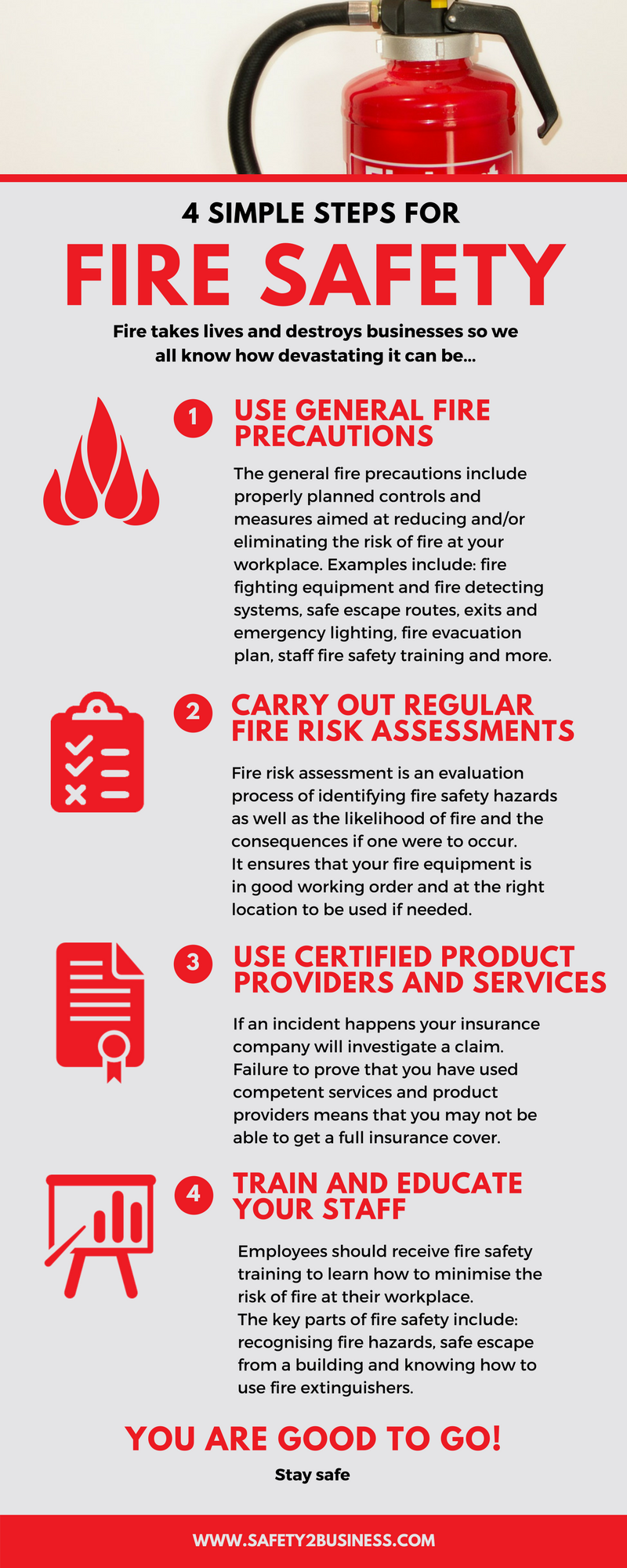











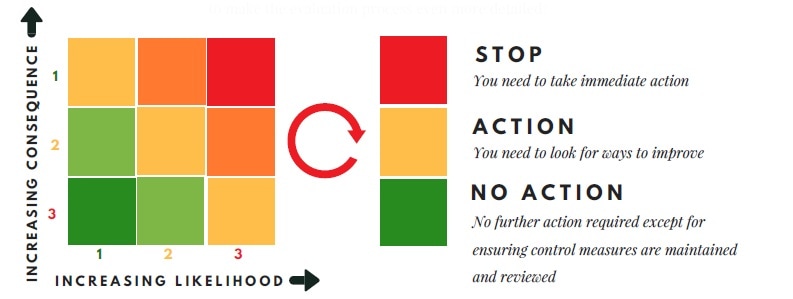


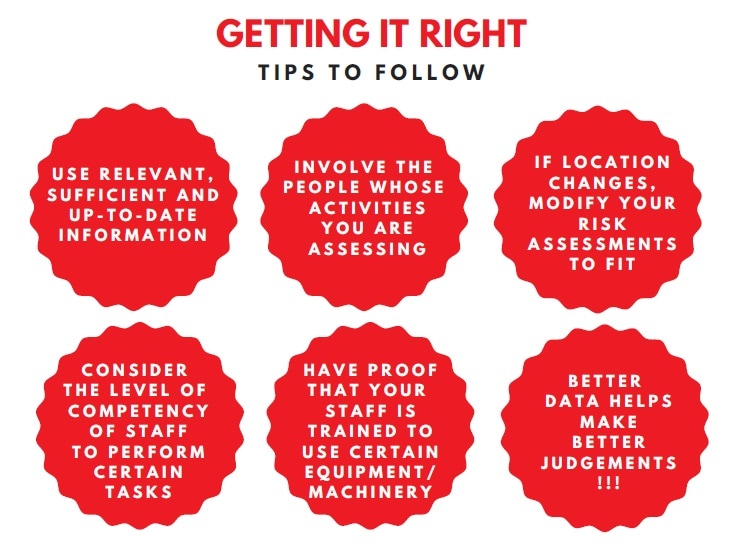

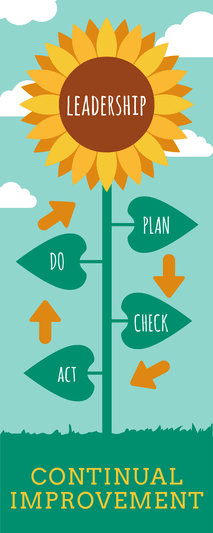
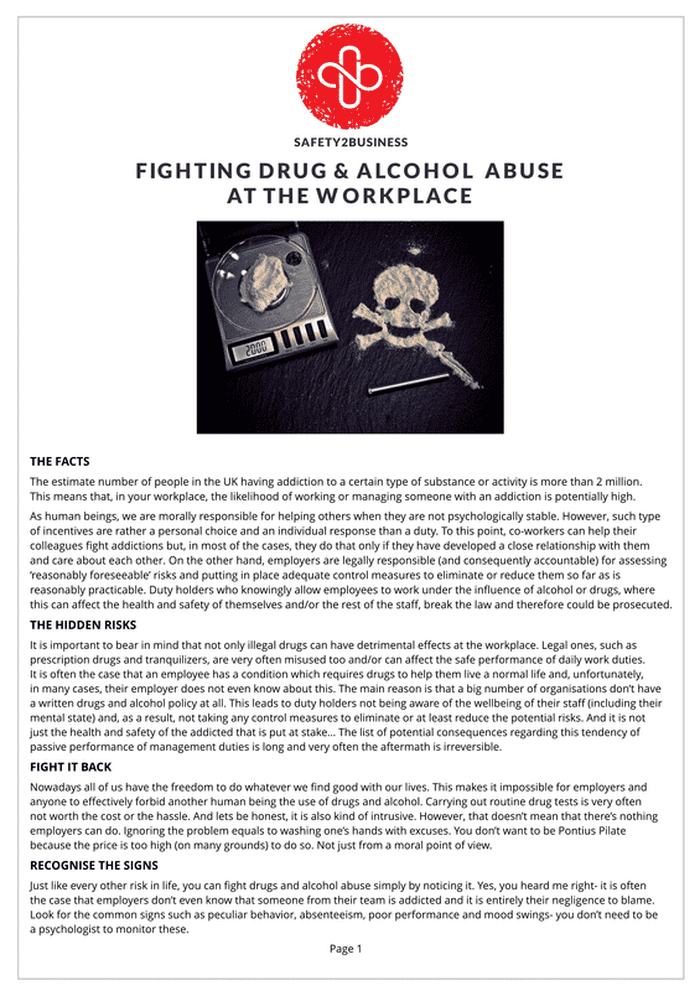

 RSS Feed
RSS Feed
